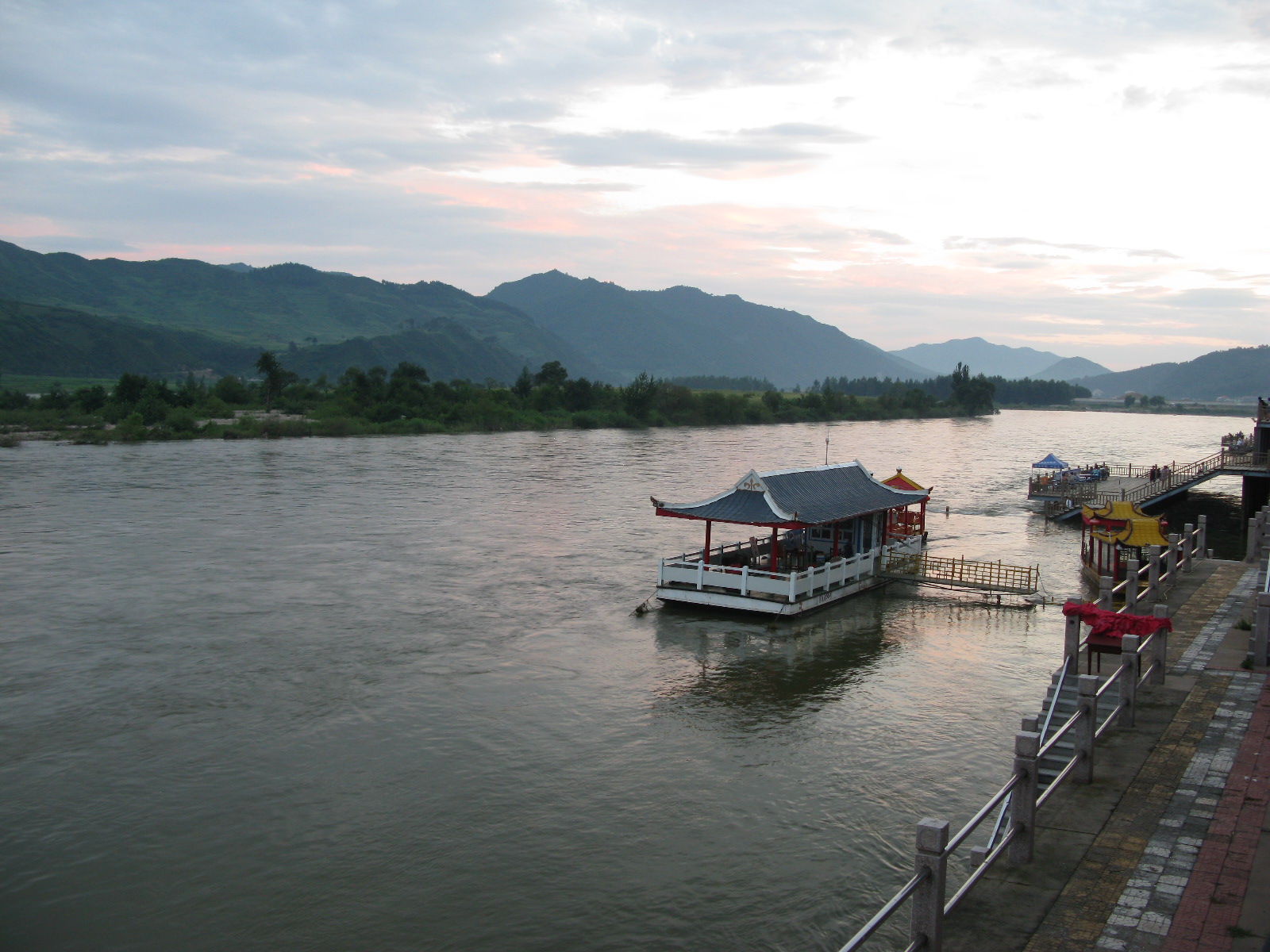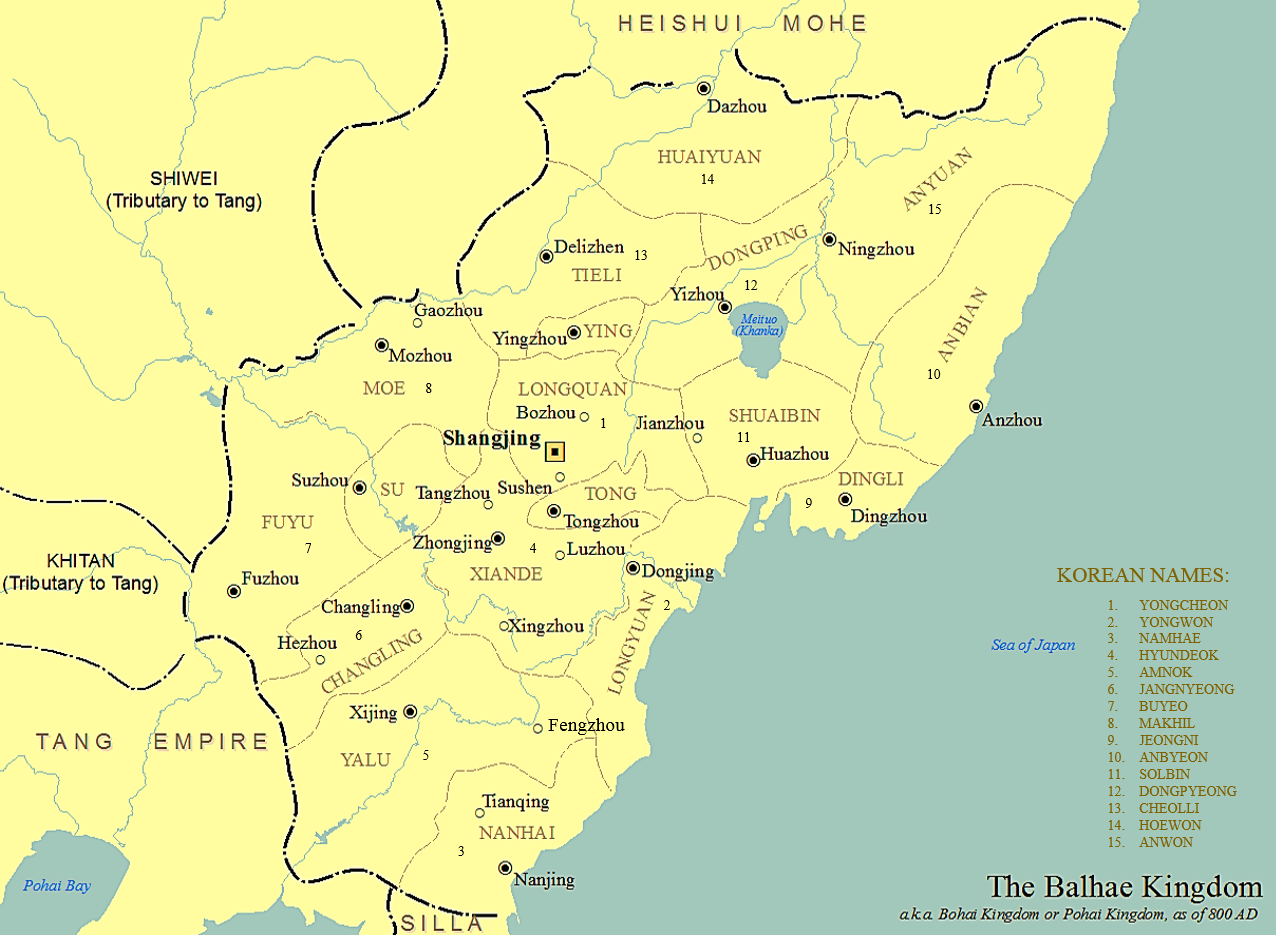|
Yeol Manhwa
Yeol Man-hwa or Lie Wanhua (; ) (?–976, r. 938–976) was the first king of Jeongan (Ding'an), a successor state to the kingdom of Balhae (Bohai), centered near the Yalu River. Biography Yeol Man-hwa served a general of Later Balhae (Later Bohai), after the fall of Balhae to the Liao dynasty. In 938, Yeol overthrew the ruling Dae clan and proclaimed himself as the king of the state of Jeongan, with the aid of Oh Je-hyeon (오제현; 烏濟顯) and the Oh clan. In 970, King Yeol Man-hwa sent tribute to the Song dynasty The Song dynasty (; ; 960–1279) was an imperial dynasty of China that began in 960 and lasted until 1279. The dynasty was founded by Emperor Taizu of Song following his usurpation of the throne of the Later Zhou. The Song conquered the rest ... during the reign of Emperor Taizu. However, in 976, Yeol Man-hwa himself was overthrown by the Oh clan, by Oh Je-hyeon's descendant, Oh Hyeon-myeong (Wu Xuanming). External links * *{{cite web , author1=한규철 ... [...More Info...] [...Related Items...] OR: [Wikipedia] [Google] [Baidu] |
King
King is the title given to a male monarch in a variety of contexts. The female equivalent is queen, which title is also given to the consort of a king. *In the context of prehistory, antiquity and contemporary indigenous peoples, the title may refer to tribal kingship. Germanic kingship is cognate with Indo-European traditions of tribal rulership (c.f. Indic ''rājan'', Gothic ''reiks'', and Old Irish ''rí'', etc.). *In the context of classical antiquity, king may translate in Latin as '' rex'' and in Greek as '' archon'' or '' basileus''. *In classical European feudalism, the title of ''king'' as the ruler of a ''kingdom'' is understood to be the highest rank in the feudal order, potentially subject, at least nominally, only to an emperor (harking back to the client kings of the Roman Republic and Roman Empire). *In a modern context, the title may refer to the ruler of one of a number of modern monarchies (either absolute or constitutional). The title of ''king'' is us ... [...More Info...] [...Related Items...] OR: [Wikipedia] [Google] [Baidu] |
Jeongan
Jeongan or Ding'an (; ko, 정안국; 938–986) was a successor state of Balhae (Bohai) founded by Yeol Man-hwa (Lie Wanhua). Establishment and Downfall The early history of Jeongan is mostly unknown. Large number of rebels emerged on the former Balhae territories after the kingdom's conquest by the Liao dynasty in 926, although most were quickly defeated by Liao forces. General Yeol Manhwa (Lie Wanhua) established Jeongan in the mid-930s, at a time when the Liao puppet state of Dongdan was abolished and the main Liao forces left the region. Jeongan is recorded to have enlisted the assistance of neighboring tribes with the hopes of overthrowing the Liao dynasty, but apparently failed to do so. The Yeol clan was replaced by the Oh clan in 976, and was ruled by Oh Hyeon-myeong (Wu Xuanming) until before it was finally destroyed by the Liao dynasty in 986 CE. Jeongan only entered historical records because of its contact with the Song dynasty. In 970, the king paid tribute t ... [...More Info...] [...Related Items...] OR: [Wikipedia] [Google] [Baidu] |
Oh Hyeon-myeong
Oh, OH, or Oh! is an interjection, often proclaiming surprise. It may refer to: Arts and entertainment Music Albums * ''Oh!'' (Girls' Generation album), 2010 * ''Oh!'' (ScoLoHoFo album), 2003 * ''OH (ohio)'', by Lambchop, 2008 * ''Oh!'', an EP that came with the preorders of ''Oh! Gravity.'' by Switchfoot, 2006 Songs * "O (Oh!)", 1920 by Ted Lewis, 1953 by Pee Wee Hunt * "Oh" (Ciara song), 2005 * "Oh!" (Girls' Generation song), 2010 * "Oh!" (Pink Lady song), 1981 * "Oh" (Stray Kids song), 2021 * "Oh!", by Boys Noize from '' Oi Oi Oi'' * "Oh!", by The Breeders from '' Pod'' * "Oh", by Dave Matthews from ''Some Devil'' * "Oh", by Fugazi from ''The Argument'' * "Oh", by Juliana Hatfield from ''Made in China'' * "Oh!", by Micky Green from '' White T-Shirt'' * "Oh!", by Sleater-Kinney from ''One Beat'' * "Oh", by Spratleys Japs from ''Pony'' * "Oh!", by The Trudy * "Oh," by Underworld, recorded for the soundtrack to A Life Less Ordinary, 1997 Other media * Oh! (TV channel), a ... [...More Info...] [...Related Items...] OR: [Wikipedia] [Google] [Baidu] |
Balhae
Balhae ( ko, 발해, zh, c=渤海, p=Bóhǎi, russian: Бохай, translit=Bokhay, ), also rendered as Bohai, was a multi-ethnic kingdom whose land extends to what is today Northeast China, the Korean Peninsula and the Russian Far East. It was established in 698 by Dae Joyeong (Da Zuorong) and originally known as the Kingdom of Jin (Zhen) until 713 when its name was changed to Balhae. Balhae's early history involved a rocky relationship with the Tang dynasty that saw military and political conflict, but by the end of the 8th century the relationship had become cordial and friendly. The Tang dynasty would eventually recognize Balhae as the "Prosperous Country of the East". Numerous cultural and political exchanges were made. Balhae was conquered by the Khitan-led Liao dynasty in 926. Balhae survived as a distinct population group for another three centuries in the Liao and Jin dynasties before disappearing under Mongol rule. The history of the founding of the state, its e ... [...More Info...] [...Related Items...] OR: [Wikipedia] [Google] [Baidu] |
Yalu River
The Yalu River, known by Koreans as the Amrok River or Amnok River, is a river on the border between North Korea and China. Together with the Tumen River to its east, and a small portion of Paektu Mountain, the Yalu forms the border between North Korea and China. Its valley became the scene of several military conflicts in the past centuries. Name Two theories are given regarding the origin of the river's name. One theory is that the name derived from ''Yalu ula'' () in the Manchu language. The Manchu word ''yalu'' () means "the boundary between two countries". In Mandarin Chinese, phonetically approximates the original Manchu word, but literally means "duck green", which was said to have been once the color of the river. The other theory is that the river was named after the combination of its two upper branches, which were called "" ( or'' Ap'') and "" ( or ''R''(or ''n'')''ok'')", respectively. Revised Romanization of Korean spelled it (; "Amnok River") and Revised Roma ... [...More Info...] [...Related Items...] OR: [Wikipedia] [Google] [Baidu] |
Later Balhae
Later Balhae or Later Bohai (927–935) was a state hypothesized to have existed in Manchuria. It emerged after Balhae(Bohai) was destroyed by the Liao dynasty. Later Balhae is considered by some to be the first of several successor states to Balhae after its fall to the Liao dynasty in 926. The existence of Later Balhae was first proposed by Japanese scholar Hino Kaizaburo in 1943 and subsequently supported by some South Korean scholars. Outside of South Korea, "Later Balhae" is usually understood as a name for the kingdom of Dongdan or other polities on the former territory of Balhae. History After the fall of Balhae, part of the land was annexed by the Khitan-led Liao dynasty, and part was incorporated into the Liao vassal Dongdan Kingdom, and the rest was inhabited by the Koguryo people who retained independence. The conquered people of Balhae immediately began rebelling against the Liao dynasty. Starting in 927, the Khitans had begun to hunt down and execute all members ... [...More Info...] [...Related Items...] OR: [Wikipedia] [Google] [Baidu] |
Liao Dynasty
The Liao dynasty (; Khitan: ''Mos Jælud''; ), also known as the Khitan Empire (Khitan: ''Mos diau-d kitai huldʒi gur''), officially the Great Liao (), was an imperial dynasty of China that existed between 916 and 1125, ruled by the Yelü clan of the Khitan people. Founded around the time of the collapse of the Tang dynasty, at its greatest extent it ruled over Northeast China, the Mongolian Plateau, the northern part of the Korean Peninsula, southern portions of the Russian Far East, and the northern tip of the North China Plain. The dynasty had a history of territorial expansion. The most important early gains was the Sixteen Prefectures (including present-day Beijing and part of Hebei) by fueling a proxy war that led to the collapse of the Later Tang dynasty (923–936). In 1004, the Liao dynasty launched an imperial expedition against the Northern Song dynasty. After heavy fighting and large casualties between the two empires, both sides worked out the Chanyuan Trea ... [...More Info...] [...Related Items...] OR: [Wikipedia] [Google] [Baidu] |
Song Dynasty
The Song dynasty (; ; 960–1279) was an imperial dynasty of China that began in 960 and lasted until 1279. The dynasty was founded by Emperor Taizu of Song following his usurpation of the throne of the Later Zhou. The Song conquered the rest of the Ten Kingdoms, ending the Five Dynasties and Ten Kingdoms period. The Song often came into conflict with the contemporaneous Liao, Western Xia and Jin dynasties in northern China. After retreating to southern China, the Song was eventually conquered by the Mongol-led Yuan dynasty. The dynasty is divided into two periods: Northern Song and Southern Song. During the Northern Song (; 960–1127), the capital was in the northern city of Bianjing (now Kaifeng) and the dynasty controlled most of what is now Eastern China. The Southern Song (; 1127–1279) refers to the period after the Song lost control of its northern half to the Jurchen-led Jin dynasty in the Jin–Song Wars. At that time, the Song court retreated south of the ... [...More Info...] [...Related Items...] OR: [Wikipedia] [Google] [Baidu] |
Emperor Taizu Of Song
Emperor Taizu of Song (21 March 927 – 14 November 976), personal name Zhao Kuangyin, courtesy name Yuanlang, was the founder and first emperor of the Song dynasty of China. He reigned from 960 until his death in 976. Formerly a distinguished military general of the Later Zhou dynasty, Emperor Taizu came to power after staging a coup d'état and forcing Emperor Gong, the last Later Zhou ruler, to abdicate the throne in his favour. During his reign, Emperor Taizu conquered the states of Southern Tang, Later Shu, Southern Han and Jingnan, thus reunifying most of China proper and effectively ending the tumultuous Five Dynasties and Ten Kingdoms period. To strengthen his control, he lessened the power of military generals and relied on civilian officials in administration. He was succeeded by his younger brother, Zhao Kuangyi (Emperor Taizong). Early life Born in Luoyang to military commander Zhao Hongyin, Zhao Kuangyin grew up excelling in mounted archery. Once, riding an un ... [...More Info...] [...Related Items...] OR: [Wikipedia] [Google] [Baidu] |
Balhae People
Balhae ( ko, 발해, zh, c=渤海, p=Bóhǎi, russian: Бохай, translit=Bokhay, ), also rendered as Bohai, was a multi-ethnic kingdom whose land extends to what is today Northeast China, the Korean Peninsula and the Russian Far East. It was established in 698 by Dae Joyeong (Da Zuorong) and originally known as the Kingdom of Jin (Zhen) until 713 when its name was changed to Balhae. Balhae's early history involved a rocky relationship with the Tang dynasty that saw military and political conflict, but by the end of the 8th century the relationship had become cordial and friendly. The Tang dynasty would eventually recognize Balhae as the "Prosperous Country of the East". Numerous cultural and political exchanges were made. Balhae was conquered by the Khitan-led Liao dynasty in 926. Balhae survived as a distinct population group for another three centuries in the Liao and Jin dynasties before disappearing under Mongol rule. The history of the founding of the state, its e ... [...More Info...] [...Related Items...] OR: [Wikipedia] [Google] [Baidu] |





